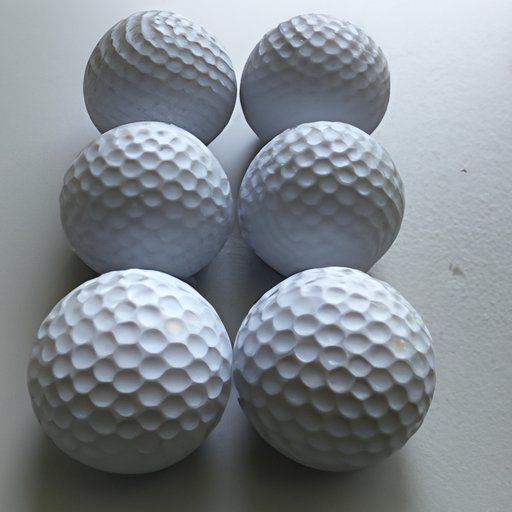Introduction
Golf is one of the most popular sports in the world, with millions of players competing every year. While it may appear to be a simple game, there is actually quite a bit of science that goes into playing it well. One of the most important elements is the golf ball itself. While most people know that golf balls have dimples, few know why they are there or how many there are. This article will explore the science behind golf ball dimples to uncover how many dimples are in a golf ball and how they affect performance on the course.

Exploring the Science Behind Golf Ball Dimples
A golf ball is made up of several layers which each serve a specific purpose. The core is the innermost layer and is typically made from rubber or synthetic materials. The core is surrounded by an outer cover, which is usually made from a blend of rubber, plastic, or other synthetic materials. The cover is then covered in hundreds of small dimples. These dimples are an essential part of the golf ball and play a key role in its performance.
The primary purpose of golf ball dimples is to reduce drag. Drag is the force that causes a golf ball to slow down as it travels through the air. By reducing the amount of drag, the golf ball can travel farther and more accurately. Dimples also help the ball spin, which is important for accuracy. When a golf ball spins, it creates a lift that helps keep the ball on its intended path.
Uncovering the Mystery of How Many Dimples are in a Golf Ball
It’s impossible to give an exact answer to this question since different golf balls have different numbers of dimples. However, the average number of dimples on a golf ball is between 300 and 500. Some golf balls may even have as many as 1,000 dimples!
It’s also important to note that not all dimples are created equal. Different golf balls may have different sizes and shapes of dimples, which can impact their performance on the course. For example, larger dimples may create less drag than smaller dimples, resulting in increased distance. Additionally, different shapes of dimples can affect how the ball spins, which can affect its accuracy.

Investigating the Relationship Between Dimples and Performance on the Course
So, how do dimples affect performance on the course? Research has shown that dimples can increase distance by up to 10 percent. Additionally, dimples can improve accuracy by helping the ball spin and stay on its intended path. In general, the more dimples a golf ball has, the better its performance will be.
However, it’s important to note that dimples aren’t the only factor when it comes to performance. Other factors such as the material of the core and cover, the weight of the ball, and the design of the dimples can all play a role. As such, it’s important to consider all of these factors when looking for the best golf ball for your game.

A Closer Look at the Anatomy of a Golf Ball
Now that we’ve explored the relationship between dimples and performance, let’s take a closer look at the anatomy of a golf ball. As mentioned earlier, golf balls typically have between 300 and 500 dimples. However, some golf balls may have as few as 200 or as many as 1,000.
In addition to the number of dimples, the size and shape of the dimples can also have an effect on performance. Generally speaking, rounder dimples are better for distance, while sharper dimples are better for spin. Additionally, larger dimples can create less drag, resulting in increased distance.
Conclusion
Golf ball dimples play an essential role in the performance of a golf ball. They reduce drag, allowing the ball to travel farther and more accurately. Most golf balls have between 300 and 500 dimples, although some may have as few as 200 or as many as 1,000. Additionally, the size and shape of the dimples can have an effect on performance. Rounder dimples are better for distance, while sharper dimples are better for spin. Understanding the science behind golf ball dimples can help you make informed decisions about which golf ball is right for your game.


